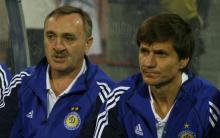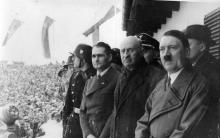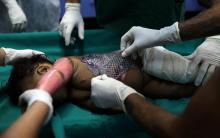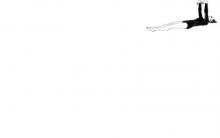Sport is an amazing opportunity for a person to support his own health. Regular exercise strengthens the body, trains endurance, and has a favorable effects on muscles, cardiovascular and respiratory systems, reduce the risk of development and occurrence of many diseases. In addition, physical education tempers character, develops willpower. So why neglect it?
In our country rapidly sport is developing, national teams compete at the international level in various sports disciplines. Russia often takes prizes, which cannot but become a reason for pride. By instilling a love of sports in the younger generation, we are making a long-term contribution to future your nation, your people. After all, classes develop not only physically, but also morally. Athletes overcome many challenges throughout their careers. This includes grueling training, the bitterness of defeat, and loss of spirit. But in no case should this become a reason to give up, but on the contrary, it should provide an incentive improve and reach new heights. I sincerely admire such people!
My family is a big sports fan. All this thanks to dad, because he is a military man, and in this area physical training plays not the least role. He developed in us the habit of doing exercises in the morning and eating right. Now I go to the pool several times a week and play basketball. I would like to achieve success in my business and reach the international level, where I can represent my country and defend its honor and right to be called champion. My parents and younger sister and I love active recreation: cycling, beach ball games, hiking. Often the weekend flies by unnoticed during such activities. I like to spend time like this, because it brings great benefit. People who do not subject their bodies to physical activity get sick much more often, because their bodies are not so strong. In old age, such people often have problems with muscles, joints and internal organs.
I like sport! How can you not love him? After all, this is a way to control your health, look good, develop as a person, and strengthen your character. I am glad that my family and state pay due attention to this issue; without this it is impossible to get healthy in all respects. generation, because in a healthy body there is a healthy mind!
Municipal budgetary educational institution
Secondary school with. Chernukha
Kstovsky district, Nizhny Novgorod region
Competition entry “I choose sports as an alternative to addictions”
COMPOSITION
"Sport - is life"
Performed 7th grade student
MBOU Secondary School s. Chernukha
Salnikova Maria
Supervisor:
Teacher of Russian language and literature
Kustareva S. A.
Refined plastic movements.
Instant throw reaction.
Oh sport! You are the educator of generations.
A great friend's faithful hand.
To run, swim, move skillfully,
The enemy, playing, win,
Put your body to work without a doubt!
There is no greater honor than creating yourself!
Sport gives us health energy,
Perseverance, fortitude, beauty.
Sport teaches us to look at the world with love,
Make your dream come true.
Now many people cannot imagine their life without sports! Football players, hockey players, gymnasts, amateurs and just ordinary people. People who choose sports! But why do they make this choice? Perhaps because thanks to sports, a person hardens, strengthens his health, becomes strong and resilient, and develops character. But there are also people for whom sport is the meaning of life.
Sport is central to the lives of many people. Why is this happening? Now there are a lot of different sports. And a person can find something suitable for himself. Perhaps by playing sports, we find ourselves in it. For example, in dance, a person can convey his feelings to the audience. While dancing, he tells them what he would be afraid to say in person. In this way he expresses his thoughts. But he does not say them directly, but with the help of a special language. The language of dance.
I believe that every person should play sports. You can start with regular exercises in the morning, because some people don’t even do that. Jogging in the morning can help a person very well. For example, you live on the eighth floor and the elevator in your house is broken; if you are doing a regular jog, then it will not be difficult for you to climb to the desired floor on foot. People who play sports professionally are a different matter. For them, sport becomes an integral part of their life. He brings them a lot of joy. They win different competitions. It happens that these competitions take place in other countries. For athletes, this is an opportunity to learn more about the world and visit different countries. Playing sports is not easy. The load increases. Not every person has such willpower that when things get difficult, he won’t give up everything he has achieved. But most often this happens at the beginning, when we are just starting to play sports. It becomes difficult for us, we are afraid, we think that we cannot handle it and in the end we quit without even trying. Sport helps us to be healthy. People who play sports get sick less often and have stronger immunity. A person who plays sports can be easily recognized by his posture and physique. No wonder they say: “A healthy mind in a healthy body.”
They start playing sports in kindergartens, strengthening the child and helping his athletic development. Perhaps already at this time the athlete in a person begins to emerge. After all, there are children who find it easy to play sports and who have athletic talent. In sports, the support provided by loved ones is important. We want to make these people proud of us and start working harder. Therefore, they have a significant influence on us. And we, in turn, become more athletic. I believe that a lazy person would not be able to play sports. He wouldn't get up early in the morning to exercise or run. Only mentally strong people can be friends with sports.
Everyone should know that nothing is more important than being healthy. And to be healthy you need to play sports. I believe that every person, waking up in the morning, should say to himself: “Movement is life.” Well, isn’t movement a sport?
Composition
People all over the world love sports and games. Sport makes people healthier, keeps them in shape, makes them more organized and disciplined. Some people play sports for health reasons, and some do it professionally. Every city has many stadiums, sports grounds, swimming pools, and football fields. Almost all sports are popular in our country, but football, figure skating and tennis are the most popular. There are many people who enjoy jogging. In the morning and evening you can see people running in parks, stadiums and even on the streets. In every school, students spend a lot of time playing sports. First of all, they have physical education classes. And after school they can train in various sports clubs and sections, playing different sports. In our country, a lot of attention is paid to professional sports. Every year many sports competitions, sports and Olympics are held. Once every four years, the Olympic Games are held in different countries. There are summer and winter Olympic Games. This is a great sporting competition of the best athletes in the world. As for me, I play table tennis (ping pong). It requires mobility, liveliness and a lot of energy. It keeps a person in good shape. I've been playing tennis for five years, but the more I play, the more I like it.
The role of sport in human life (essay)
There are people for whom sport is the meaning of life. These athletes are famous all over the world. They are masters of sports and set their personal records and win gold medals. This sport is called professional.
I want to write about amateur sports that are available to everyone. Sport plays a big role in people's lives. It improves health, develops character, makes a person strong and resilient, and strengthens the body. Besides, I think playing sports improves your mood.
I believe that every person needs to play sports. Sport improves health and develops physical abilities. A person involved in sports is immediately visible. He is distinguished by his smartness and beautiful posture. No wonder they say: “A healthy mind in a healthy body!” People who exercise get sick less. Exercise brings health back to many people. I read about the Russian circus performer Dikul, who performed a routine where he lifted weights that weighed pounds. A misfortune happened to him - he got into a car accident. He subsequently lay in hospital with a broken back.
He was able to return to normal life and perform in the circus again thanks to daily physical exercise. I believe that this is the benefit of playing sports.
Sport brings great joy. People go to sections, visit sports clubs, play sports games, get stronger and communicate with new people. Sports team games bring the joy of victory. Traveling to different cities and countries for competitions is the most interesting side of the sport.
All this and much more brings great joy.
Sport develops a person's character. Playing sports strengthens willpower and disciplines people. A lazy person will not get up early every day to jog or douse himself with cold water. Only mentally strong people can be friends with sports. In my opinion, the words from the song: “Real men play hockey, a coward does not play hockey,” confirm exactly this.
There is nothing more important than human health, and to be healthy, you need to play sports. Everyone should know this! It is not for nothing that all preschool and school institutions and even universities have a program for the physical education of children and adolescents. I believe that the motto of every person should be: “Movement is life!”
Municipal educational institution"Secondary school No. 12"
city of Rzhev, Tver region
Project on:
"Sports in my life"
Performed:
student of class 3 "A"
Municipal educational institution "Secondary school No. 12"
G. Rzheva
Malygina Daria
Project Manager:
Queen Margaret
Alekseevna
Rzhev
2017
Content
Introduction
ChapterI. History of sports
ChapterII. Sports in our life
2.1. What is sport?
ChapterIII. Practical part
3.3. Questionnaire and its results.
Conclusion
Introduction
Sport! What a small but very important word in a person’s life. Our life is unthinkable without sports. Everyone gets something different from sports. For some, this is a colorful spectacle, like a performance. For others, it’s health promotion. Still others choose sport as their profession. For us, schoolchildren, sport is health, physical training, endurance, excellent health, good mood, self-confidence and self-confidence. Unfortunately, nowadays many guys spend almost all their free time at the computer or in game rooms. But every year in September, coaches from various sports sections come to our school and invite children to play sports. Many classmates take business cards from them with a schedule and promise to come to class. Then they forget about them or go to 1-2 classes and quit. I thought: “Why don’t my classmates want to play sports? Maybe they don’t know enough about what sport gives us?”
The purpose of my research: identify the impact of sports on the health, physical fitness and studies of my classmates.
Tasks:
learn what sports are and why do them,
what do sports give you?
find out the impact of sports on physical fitness, health,
consider a sport such as gymnastics,
conduct a survey and find out the attitude towards sports of my classmates,
draw conclusions.
Chapter I. History of sports
The history of the development of sports goes back tens of thousands of years. Since ancient times, man has strived to be stronger, faster, more resilient. In those distant times, these qualities were necessary for human survival. Since then, people began to regularly train their skills, develop them and pass this knowledge on to subsequent generations.
For example, the Australian aborigines regularly trained their archery skills, which helped them hunt successfully. They also trained skills such as running and boomerang throwing. Something similar can be found in other cultures. For example, American Indian tribes regularly trained in long-distance running, lifting stones of varying weights, and much more. Among African tribes, such practices as fencing with sticks, running with a load, and wrestling became widespread.
As for sports competitions, the earliest mentions of such events are found in ancient manuscripts of the 4th-3rd millennium BC. The main disciplines in which the participants competed were archery, horse riding, running over different distances, wrestling, fencing with various types of weapons, and ball games. It is also worth mentioning Egypt's rich sporting past. Scientists have discovered more than 400 types of sports exercises depicted on the walls of the Great Pyramids.
The sport reached its greatest flourishing during the existence of Ancient Greece, where the Olympic Games originated. In the history of sports, the ancient Greek Olympic Games are of particular importance, since it was then that sport turned from a utilitarian, applied tool into a cultural value. For the ancient Hellenes, sport was inextricably linked with mental, aesthetic and moral development, and was the basis for the harmonious development of the individual. “He can neither read nor swim,” this is what they said in Ancient Greece about an uncultured person. And the Olympic Games themselves have become a practical embodiment of the unity of body, will and mind.
The history of sports is rich in various spectacular events. People have been training their skills since ancient times and it has always been a good way to lead a peaceful and healthy life.
Modern sport can be divided into two categories: mass sport (the so-called “Sport for everyone”) and sport of the highest achievements. And elite sports can be divided into professional and amateur.

The history of sport in its modern form dates back to the 14th and early 20th centuries. It was at this time that sports popular in Russia began to actively take shape. Also at this time, many international sports organizations were formed, and the Olympic movement was revived.
Chapter II. Sports in our life
2.1. What is sport?
In the explanatory dictionary of the Russian language by S.I. Ozhegov it is written: “Sport is an integral part of physical culture - sets of physical exercises for the development and strengthening of the body.” There are about 500 sports in the world. Sport, as a rule, is a profession, and physical education is entertainment, although sport begins with physical education.
2.2. Why play sports?
A weak person can always become strong. The value of playing sports lies not only in improving health and physical development. We acquire agility, speed, strength, endurance and also valuable human qualities: concentration and discipline. Those who participate in sports have fewer difficulties in their studies. And most importantly, sport teaches us to be friends, we know how to rejoice in the successes of others and empathize with failures. I want to talk a little about the sport that is closest to me - gymnastics.
2.3 What is gymnastics and its types.
Gymnastics is a sport, as well as a part of physical education, divided into artistic, sports, team, aerobic, aesthetic and acrobatic gymnastics. To improve their health, they perform morning gymnastics exercises, conduct physical education sessions in schools during breaks, elements of this sport are included in the physical education program, and sometimes gymnastic exercises are carried out to treat various diseases during physical therapy (physical therapy) classes. Develops endurance, coordination, trains balance, strength, flexibility, and gives skills in performing complex exercises.

History of the development of gymnastics.
Gymnastics as a sport originated in Ancient Greece, and the origin of this term (gymnazo) is also Greek - translated it can mean “to train, to teach.”
Some gymnastic equipment, such as the horse, existed in ancient times. They did gymnastic exercises on horseback to help them master horse riding.
In the Middle Ages there was no gymnastics as such, but there were undoubtedly gymnastic elements in the military training of knights. For example, the Templars were forbidden to retreat, even if the opponents were three times more numerous - so training included stretching, resourcefulness and acrobatic elements in order to survive in an unequal battle.
In the late Middle Ages, there were attempts to revive the ancient experience of gymnastic exercises. At this time, a set of vaulting exercises was born - on a horse, a table, climbing a wall, a pole, balance exercises on a deck, a rope.
Gymnastics was well developed among traveling circus performers, but precisely because of this, it was not perceived in high society and was considered the lot of common people. But with the development of equality in society, everything soon changed.
At the turn of the 18th - 19th centuries in Germany, philanthropist schools theoretically developed a sports theme, and gymnastics appeared as a separate subject.
In 1881, three countries - Holland, Belgium and France - created the FEG - the European Gymnastics Federation. In 1921, this organization became the International Gymnastics Federation (FIG), which to this day combines artistic gymnastics, rhythmic gymnastics, acrobatics, sports aerobics and trampolining. The federation includes 125 countries. In 1982, the European Gymnastics Union was founded, which today includes 46 countries; it holds European Championships independently of the international organization.
Kinds
Artistic gymnastics has been an Olympic sport since 1896. It existed as a sport in Ancient Greece. Competitions are held in vaults, floor exercises and various apparatus - uneven bars, rings, deck, pommel horse, beam.

Rhythmic gymnastics - performing exercises (with a skipping rope, hoop, ribbon, mace, ball) that are combined into a musical dance. There are group exercises in which athletes use balls and hoops or one type of object at the same time.

Team gymnastics originates from the Scandinavian countries and competitions have been held since 1996. There are three types of exercises - floor, acrobatic jumps and mini-trampoline. There are individual and team competitions, women, men, or both in one team.

Circus gymnastics - spectacular performances on apparatus fixed to the floor (horizontal bars, rings, trampolines) or in the air, aerial gymnastics (cord de shuttlecock, trapeze, aerial horizontal bar, canvases, rings and others).

Acrobatic gymnastics - pairs, group exercises, acrobatic jumps.

Sports aerobics is a sport in which exercises are difficult to coordinate; you also need to interact between partners, performing unique aerobic steps. In 1995, aerobics gained recognition and entered the International Gymnastics Federation.

Different types of health-improving gymnastics.
Health activities
Health-improving types of gymnastics develop the musculoskeletal system, reaction, mobility, flexibility, strength, and improve the functioning of the cardiovascular system:
Rhythmic gymnastics consists of jumping, running movements, bending, and squats, which are performed to fast, dance music.
Yoga - different poses (asanas), breathing and psychoregulation exercises. It is the peculiarities of psychoregulation that lead to the conclusion that yoga is nothing more than a peculiar eastern sect that has a detrimental effect on the psyche, since it is based on Indian religious practices. Asanas lead to excessive stress and unnecessary stretching; the healing effect is possible mainly through self-hypnosis. The harm of yoga has not yet been fully studied. Since gymnastics is associated with mobility, and yoga is mainly static, only stretching methods can be called gymnastics here.
Health walking is practiced in an accelerated mode, at a speed of more than seven kilometers per hour. Since running at this pace is easier than walking, this gymnastic activity is recommended only if there are contraindications, such as heart disease. Practiced in physical education classes.
Industrial gymnastics also refers to physical education. The principle is the activation of muscles needed for a particular type of work, as well as increased blood circulation during sedentary work, where labor productivity depends on physical well-being.
Morning exercises have hygienic purposes, training the body after waking up.
Women's gymnastics is designed to make motherhood easier; it develops endurance of the muscles, abdomen, back, legs, and pelvis. Gymnastics for pregnant women and after childbirth also belong to this type.
Professional gymnastics increases the body’s capabilities for a certain area of physical activity and improves professional skills.
Athletic gymnastics is aimed at increasing muscle mass, endurance, and strength. Muscle enlargement should be treated with caution, as it can lead to cardiovascular diseases. You need to develop harmoniously - improve the respiratory system, strengthen blood vessels.
Therapeutic exercise (physical therapy) is a type of simple gymnastic exercises that help overcome the consequences of various diseases, mainly of an orthopedic nature.
In the USSR, gymnastics was extremely developed, there are many publications on this topic, but just look at the facts - the women's team at the Olympics was first a record 10 times, and the men's team five times. Larisa Latynina won 18 Olympic medals, including 9 gold. Nikolai Andrianov won 15 medals at the Olympics, 7 of them gold. And in 1980, gymnast Alexander Dityatin won eight medals out of a possible eight, including 3 gold. In 1992, Vitaly Shcherbo (CIS team) won 6 gold medals.


Chapter III . Practical part
3.1. Gymnastics is in my family.
We discussed the question of the benefits of sports in a person’s life in my family. My dad did gymnastics for 7 years. He has participated in various competitions and has certificates and diplomas.



I myself have been doing artistic gymnastics for three years now and I really like it. I go to the gym 4 times a week. Each lesson lasts 2 hours. Mom believes that playing sports is a lot of work. It takes a lot of effort to achieve results. Sport teaches me to overcome difficulties and builds character. Mom is sure that, thanks to gymnastics, I have my own daily routine. For me, gymnastics is a whole world of beauty, which gives me not only health, but also a great mood and self-confidence.
My coach is Tatyana Aleksandrovna Rumyantseva. It is with the help of this wonderful person that I get to know the wonderful world - the world of artistic gymnastics. Tatyana Aleksandrovna explains to her students that they must go to training constantly and try not to miss them. After all, constant physical education improves your physique, your figure becomes slender and beautiful, your movements become more expressive and flexible. Those who engage in physical education and sports increase their self-confidence and strengthen their willpower, which helps them achieve their life goals.
Physical culture and sports have a beneficial effect on the neuro-emotional system, prolongs life, rejuvenates the body, and makes a person more beautiful. Neglect of physical education leads to obesity, loss of endurance, agility and flexibility. Insufficient physical activity during the growth and development of children and adolescents can cause many adverse consequences: it leads to deterioration of health, decreased physical and mental performance, and creates preconditions for the development of various forms of pathology.
Tatyana Aleksandrovna emphasizes that physical culture and sports occupy a particularly important place in the formation and development of strong-willed traits of our personality, in the stimulation of material and spiritual culture. These strong-willed traits are: will, restraint, determination, courage,
self-control and others.
Sport, without a doubt, is one of the main means of cultivating movements, improving their subtle and precise coordination, and developing the motor physical qualities necessary for a person. But not only. In the process of playing sports, his will and character are strengthened, his ability to manage himself, quickly and correctly navigate in a variety of difficult situations, make decisions in a timely manner, take reasonable risks or refrain from risks is improved. An athlete trains alongside his comrades, competes with rivals and is sure to be enriched by the experience of human communication and learns to understand others.
Artistic gymnastics is a path that many people follow throughout their lives, strengthening their body, strengthening their spirit, discovering more and more new abilities in themselves and pushing the boundaries of their capabilities.
In my still small sports life there have been no competitions yet. But I hope to take part and receive my rewards soon.
3.2 A set of exercises for doing gymnastics.
Our trainer, Tatyana Aleksandrovna, has developed a sequence of exercises for conducting our classes:
it all starts with a warm-up: we pull the splits, do a handstand, then do swings on the wall bars, raise our legs from corner to corner and do a side stand,
trampoline: jumping with a 360º turn,
we move on to the uneven bars: we learn how to do the dismount and rocking chair correctly, as well as double flips,
balance beam: handstand on a small beam, jumping in the third position, then move to a large beam and do the same, do the splits,
track: we stand on our tiptoes and turn in different directions, stand on the bridge from a lying and standing position, make swinging movements with our right leg, transitioning into a jump and landing on a full foot,
then we do the same turns and jumps on a large log,
rope: rope climbing without legs.
men's parallel bars: walking on parallel bars on your hands.
This concludes our lessons.
3.3. Questionnaire and its results .
In order to find out the attitude of my classmates towards sports, I conducted a survey, which consisted of several questions:
Do you attend a sports section?
The number of boys and girls who attend sports sections.
Children's preferences in sports.
After conducting a survey, I concluded thatmany guys don't play sports. Of the 25 respondents, the majority is 17 people, that is, 68% of the class do not attend sports sections. And only 8 peopleAfter school they go to sports clubs, which is 32%.
Then I wanted to know how many boys and girls attend sports clubs. And I found out that only 1 girl and 7 boys from the class are involved in sports.
My third question was - what sports sections do the guys in our class prefer? 6 people (75%) attend the sambo section and 2 people (25%) attend artistic gymnastics.
Conclusion
And gymnastics classes also make you feel the joy of your own achievements. What I couldn’t do a couple of months ago, I now do with ease. And I understand the value of the effort and work on yourself. And besides, I realized that perseverance helps well in achieving any goals.




You don't have to be a professional athlete to enjoy the benefits and enjoyment of sports. Many people run in the morning, some go to aerobics and fitness, some play football. The main thing is that you like it. At the same time, it makes you physically strong and confident, and also gives you the opportunity to meet many interesting people. I want to pass on my passion to other kids, get them interested, and introduce them to the sport.
Bibliography
E.N. Litvinov, L.E. Lyubomirsky, G.B. Maxson "How to become strong and resilient."
S.A. Netopin “For schoolchildren about study and leisure”,
Robert Rothenberg "Growing Healthy"
M.Ya. Studenikin “Book about children’s health”,
Titov Yu.E. Climbing: Gymnastics at the Olympics,
Skorokhodov M.N., Sychev A.V., Kunin E.I. Faculty of Physical Education. Pages of history,
Kuznetsov B.A. Artistic gymnastics in the USSR.M.,
Turishcheva L.I. My life is gymnastics. M.,
Samin D.K. The most famous athletes of Russia (Articles about V. Chukarin, B. Shkhlin, L. Latynina, L. Turishcheva, O. Korbut,
N. Andrianove) M.,
Gymnastics and teaching methods: Textbook for physical education institutes/Ed. V.M. Smolevsky. - Ed. 3rd, revised, additional - M.: Physical education and sports,
Menkhin Yu.V. Physical training in gymnastics. - M.: Physical education and sports,
Gymnastics all-around: Women's events / Ed. Gaverdovsky Yu.K. - M.: Physical education and sports,
Gymnastic terminology: Reference. on the course "Gymnastics" / Comp. S.A. Alexandrov. - Grodno: Grodno State University,
Petrov P.K. Methods of teaching gymnastics at school: Textbook. for students higher textbook establishments. - M.: Humanite. ed. VLADOS center.











Daddy's girls: Anastasia Potanina Public service, political and social activities
Rally driver Leonid Novitsky
Interactive game "one hundred to one"
Guerrilla tactics: march, raid, battle and ambush in the forest
Obituary of Valery Kharlamov